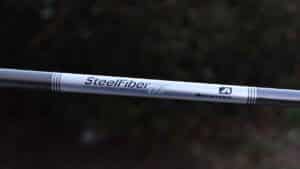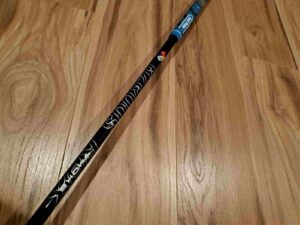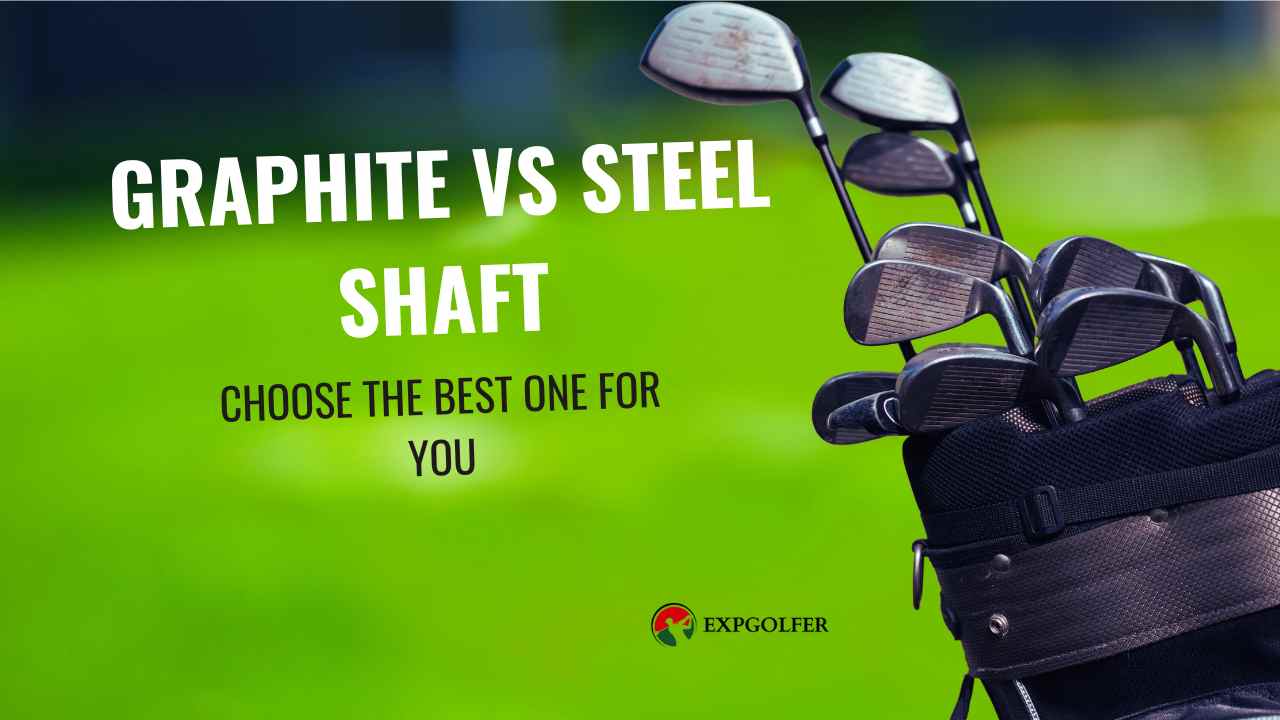Graphite and steel shafts differ in composition, weight, flexibility, feel, and performance.
Lightweight graphite shafts allow for more incredible swing speeds and distances. Also, they’re flexible, dampen vibrations, and promote higher ball trajectories.
Conversely, steel shafts provide stability, accuracy, and durability. Their precision and control make them popular among players. In the end, it comes down to your choices and playing styles.
Below is a detailed comparison of graphite vs steel shafts. Here, you will see the advantages and disadvantages of both materials and the best way to use them.
Steel Shafts

Steel shafts are traditionally known for their durability and consistency. Previously heavy and limited in flexibility, they are now lighter and more versatile.
Due to advances in manufacturing techniques and metal metallurgy, steel shafts now range from 80g to 70g in weight. Typically made from carbon steel, it gives golfers a sense of control and accuracy.
Advantages of Steel Shafts:
- Enhanced control and accuracy.
- Reduced lateral shifting and torque.
- Higher feedback for swing adjustments.
- Inexpensive compared to graphite.
- Durable and long-lasting when properly cared for.
Drawbacks of Steel Shafts:
- It may cause discomfort for individuals with chronic issues.
- Slightly reduced swing speed and potential yardage.
- Transmit more vibrations to the hands during the swing.
Graphite Shafts

With technological advances in graphite shaft manufacturing, they are more durable and accurate. They are popular with golfers of all levels.
For golfers seeking greater distance and control, graphite shafts are more forgiving on off-center shots. With advancements in carbon composites, they rival steel counterparts for durability, consistency, and distance.
From lightweight options around 50 to 65g to heavier models reaching up to 100g, graphite shafts offer enhanced swing speed and comfort. Graphics and colors add an artistic touch to club design, setting them apart.
Advantages of Graphite Shafts:
- Higher yardage potential due to increased swing speed.
- Vibration-free, especially for players with slower swing speeds.
- Less rigid, offering a smoother swing feel.
- Suitable for seniors and ladies
- Provide lighter weight and longer length.
Drawbacks of Graphite Shafts:
- Swing flaws due to increased flexibility.
- Higher cost than steel shafts.
- Players with inconsistent swings may lose accuracy.
Comparison Table: Graphite Shafts vs Steel Shafts
In the table below, you’ll find an explanation of the main differences between graphite and steel shafts in golf clubs:
| Highlights | Steel Shafts | Graphite Shafts |
| Swing Speed | Suited for faster swing speeds. | Ideal for slower swing speeds. |
| Precision & Consistency | Offers excellent precision and consistency. | Provides a softer feel and may require adjustments for precision. |
| Feel at Impact | Offers a firmer feeling at impact. | Provides a softer feel at impact. |
| Durability | Known for durability and resilience. | Generally durable but may require special care. |
| Affordability | Typically more affordable than graphite shafts. | May be more expensive than steel shafts. |
| Special Considerations | Limited customization options. | Offers a wider range of customization options. |
Differences Between Graphite Shafts and Steel Shafts?
Golf clubs mainly use graphite and steel shafts, each with characteristics and benefits. Although both materials have been used in golf clubs for years, they differ significantly.
For golfers, understanding the differences between graphite and steel shafts is essential. Let’s see what makes them different:
- Weight:
A graphite shaft is lighter by 30-60 grams than steel, enabling faster swing speeds. The lightweight nature of graphite shafts makes them easier to swing.
Steel shafts, although heavier, provide a solid and stable feel during the swing. Besides improving distance, this added weight can improve accuracy and control.
- Materials and Construction:
Carbon fiber sheets make graphite shafts lightweight and flexible. Over time, these materials can deteriorate, affecting performance and durability.
On the other hand, steel shafts are constructed from different steel alloys. They offer consistent performance over time, requiring minimal maintenance like graphite.
- Flexibility:
More flexible graphite shafts allow the clubhead to whip faster at impact. This flexibility increases launch angles and distances.
Steel shafts are solid and flex-limited. Although this limits clubhead speed, it improves control and shot shaping. Also, it improves precision and consistency for players who value accuracy.
- Vibration Damping:
Graphite shafts absorb shock at impact, making them more comfortable and vibration-dampening. This feature helps players who get tired or uncomfortable throughout long games. Graphite shafts reduce hand vibrations, making ball contact smoother.
Steel shafts vibrate players’ hands more when hit. Especially on mishits, this may cause discomfort or tiredness. Stronger steel shafts may fit players who like more feedback during their swing.
- Shot Trajectory:
High ball flight from graphite shafts can result in greater carry distances and smoother green landings. With this launch angle, the ball stays in the air longer, potentially increasing carry distance.
Steel shafts lower ball flight trajectory, which can help in windy situations and provide a penetrating ball flight. Low launch angles improve shot stability and control in windy conditions.
- Control and Accuracy:
Graphite shafts may require swing mechanic changes for control and accuracy, especially for inconsistent swingers. Despite their flexibility and dynamic nature, graphite shafts may decrease shot control.
Because steel shafts are rigid and twist-resistant, they are precise. Using this trait, golfers can accurately shape the ball’s trajectory and aim line.
- Swing Speed:
A graphite shaft can increase clubhead speed and distance for golfers with slow swing speeds. In contrast to steel shafts, graphite shafts are lightweight, facilitating a smoother swing motion.
Those with faster swing speeds prefer steel shafts for their control and stability. It is possible to harness power more effectively with steel shafts when they are heavier.
- Durability
Graphite shafts are renowned for their exceptional durability, owing to their layered carbon fiber composition. From extra-soft to firm, this design caters to various swing speeds and shot preferences.
In contrast, steel shafts are prized for their strength and durability. With each swing, they transfer excellent energy, maximizing their distance potential. As a result of their limited flex, steel shafts can benefit players with smooth, aggressive swings.
- Feedback and Feel:
Usually, graphite shaft provides a smooth and comfortable feel due to its softer and damping properties. With their muted feedback, they promote a more enjoyable and controlled experience on the course.
A steel shaft provides instant and precise feedback on every shot due to its solidity and density.
Skilled players use this feedback for self-diagnosis and adjustment. The firmness of steel shafts provides a penetrating ball flight and confidence in players.
- Consistency and Distance:
A graphite shaft flexes and loads during the swing, making it difficult for some players to achieve optimal consistency.
Although graphite shafts are flexible, they sacrifice precision and control compared to steel shafts.
On the other hand, steel shafts provide superior consistency due to their stiffness and twist resistance. Golfers can develop high-quality swing motions with it because of their weighted feel.
- Cost:
The materials and manufacturing processes involved in graphite shafts make them more expensive. They are more costly because of their lightweight properties and advanced technologies.
Steel shafts offer a more cost-effective option, making them a preferred choice for shafts. budget-conscious golfers. Their lower price makes them more affordable than graphite.
Who Should Use a Steel Shaft?
Typically, golfers prioritizing control, consistency, and accuracy prefer steel shafts. Here are some reasons why steel shafts are helpful:
Steel shafts are well-suited for golfers with faster swing speeds.
- Players who seek precision and consistency will benefit from steel shafts.
- Steel shafts are superior to graphite for those who prefer a firmer feeling at impact.
- Golfers who are looking for durability should consider steel shafts.
- Most budget golfers prefer steel shafts over graphite shafts.
Who should use a Graphite shaft?
There are many reasons why graphite shafts are recommended for golfers:
- Players with Slower Swing Speed.
- Older golfers may benefit from graphite shafts due to their lighter weight.
- Golfers with joint or muscle problems may benefit from graphite shafts.
- Players seeking customization: Steel shafts come in limited colors, flex options, and designs.
- For those looking for an enhanced feel, Graphite shafts are ideal for them.
Steel or Graphite Shafts: Which is Better?

Graphite shafts are better for golfers seeking lightweight options, while steel shafts offer more control and durability. Therefore, the best choice depends on the type of golf game you are playing.
Graphite shafts are generally best for players with slower swing speeds who seek more distance and vibration dampening. They’re popular among beginners and have physical limitations.
With steel shafts, players can hit shots faster and more accurately. For beginners, graphite shafts are often recommended due to their forgiveness and ease of use.
In the end, your choice will depend on your preferences, swing characteristics, and desired performance attributes.
Graphite or steel iron shafts for beginners?
Graphite iron shafts are generally recommended for beginners due to their lighter weight. As a result, clubhead speed and distance increase, facilitating easier ball striking.
A graphite shaft also dampens vibrations, minimizing discomfort from mishits. With graphite shafts, beginners can develop confidence and consistency in their swings.
In some cases, beginners may switch to steel shafts as their skills advance and they seek greater control.
Do pros use steel or graphite shafts for irons?
Professionals predominantly use steel shafts for their irons. Steel shafts provide superior control, consistency, and feedback for highly skilled players who demand precise shots.
With steel shafts, pros can shape shots effectively and achieve desired trajectories. Graphite shafts may provide increased distance and vibration dampening. Despite this, most professionals prefer steel shafts due to their control and feel.
Are graphite or steel shafts better for irons?
Steel shafts are generally better for irons due to their superior control, consistency, and feedback. Steel shafts provide golfers with stability due to their weight and stiffness.
Many golfers prefer steel shafts over graphite shafts, especially those who like precision in shot shaping or who have fast swing speeds. The choice between steel and graphite shafts ultimately comes down to personal preferences.
FAQ
Which shaft should I use?
You should talk to a professional golf instructor or equipment specialist for advice. They can help you determine the best shaft for your swing style and goals.
Are graphite shafts easier on the body?
Yes, graphite shafts dampen vibrations upon impact, which makes them more accessible on the body than steel shafts. Due to this feature, they are particularly beneficial to golfers with arthritis or joint issues.
When Should I Switch To Graphite Shafts?
You shouldn’t just switch to graphite shafts because of your handicap, but also ball flight, swing speed, and carry distance.
When distance declines despite other efforts, graphite shafts may be the answer.
Should Older Golfers Use Graphite Shafts?
When golfers experience a significant decrease in distance or struggle with their ball flight, graphite shafts may be a good option.
In cases of slow swing speeds or joint strain, graphite shafts can boost clubhead speed.
Take Away
The type of shaft you choose depends on your preferences and style of play. Graphite shafts offer a lightweight option that can increase swing speed and distance but lack consistency.
Alternatively, steel shafts offer more control, accuracy, and durability, but slower swing speeds might not benefit from them.
Therefore, you should try both types under a variety of conditions to identify which is most suitable for you. In the end, choosing the right equipment can significantly improve your golfing experience.

